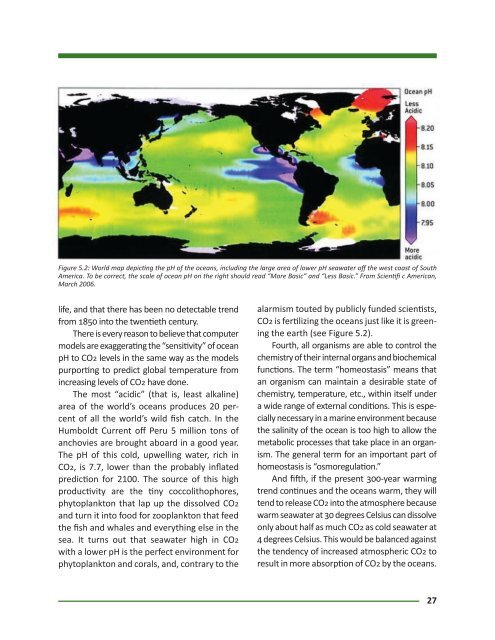The Climate Surprise
The-Climate-Surprise_CO2C-New-Criterion-1
The-Climate-Surprise_CO2C-New-Criterion-1
You also want an ePaper? Increase the reach of your titles
YUMPU automatically turns print PDFs into web optimized ePapers that Google loves.
Figure 5.2: World map depicng the pH of the oceans, including the large area of lower pH seawater off the west coast of South<br />
America. To be correct, the scale of ocean pH on the right should read “More Basic” and “Less Basic.” From Scienfi c American,<br />
March 2006.<br />
life, and that there has been no detectable trend<br />
from into the tweneth century.<br />
<strong>The</strong>re is every reason to believe that computer<br />
models are exaggerang the “sensivity” of ocean<br />
pH to CO levels in the same way as the models<br />
purporng to predict global temperature from<br />
increasing levels of CO have done.<br />
<strong>The</strong> most “acidic” (that is, least alkaline)<br />
area of the world’s oceans produces 20 percent<br />
of all the world’s wild fish catch. In the<br />
Humboldt Current off Peru 5 million tons of<br />
anchovies are brought aboard in a good year.<br />
<strong>The</strong> pH of this cold, upwelling water, rich in<br />
CO, is 7.7, lower than the probably inflated<br />
predicon for 2100. <strong>The</strong> source of this high<br />
producvity are the ny coccolithophores,<br />
phytoplankton that lap up the dissolved CO<br />
and turn it into food for zooplankton that feed<br />
the fish and whales and everything else in the<br />
sea. It turns out that seawater high in CO<br />
with a lower pH is the perfect environment for<br />
phytoplankton and corals, and, contrary to the<br />
alarmism touted by publicly funded sciensts,<br />
CO is ferlizing the oceans just like it is greening<br />
the earth (see Figure 5.2).<br />
Fourth, all organisms are able to control the<br />
chemistry of their internal organs and biochemical<br />
funcons. <strong>The</strong> term “homeostasis” means that<br />
an organism can maintain a desirable state of<br />
chemistry, temperature, etc., within itself under<br />
a wide range of external condions. This is especially<br />
necessary in a marine environment because<br />
the salinity of the ocean is too high to allow the<br />
metabolic processes that take place in an organism.<br />
<strong>The</strong> general term for an important part of<br />
homeostasis is “osmoregulaon.”<br />
And fih, if the present -year warming<br />
trend connues and the oceans warm, they will<br />
tend to release CO into the atmosphere because<br />
warm seawater at degrees Celsius can dissolve<br />
only about half as much CO as cold seawater at<br />
degrees Celsius. This would be balanced against<br />
the tendency of increased atmospheric CO to<br />
result in more absorpon of CO by the oceans.<br />
27


